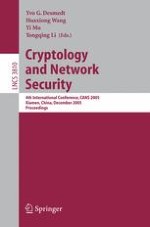2005 | Book
Cryptology and Network Security
4th International Conference, CANS 2005, Xiamen, China, December 14-16, 2005. Proceedings
Editors: Yvo G. Desmedt, Huaxiong Wang, Yi Mu, Yongqing Li
Publisher: Springer Berlin Heidelberg
Book Series : Lecture Notes in Computer Science
